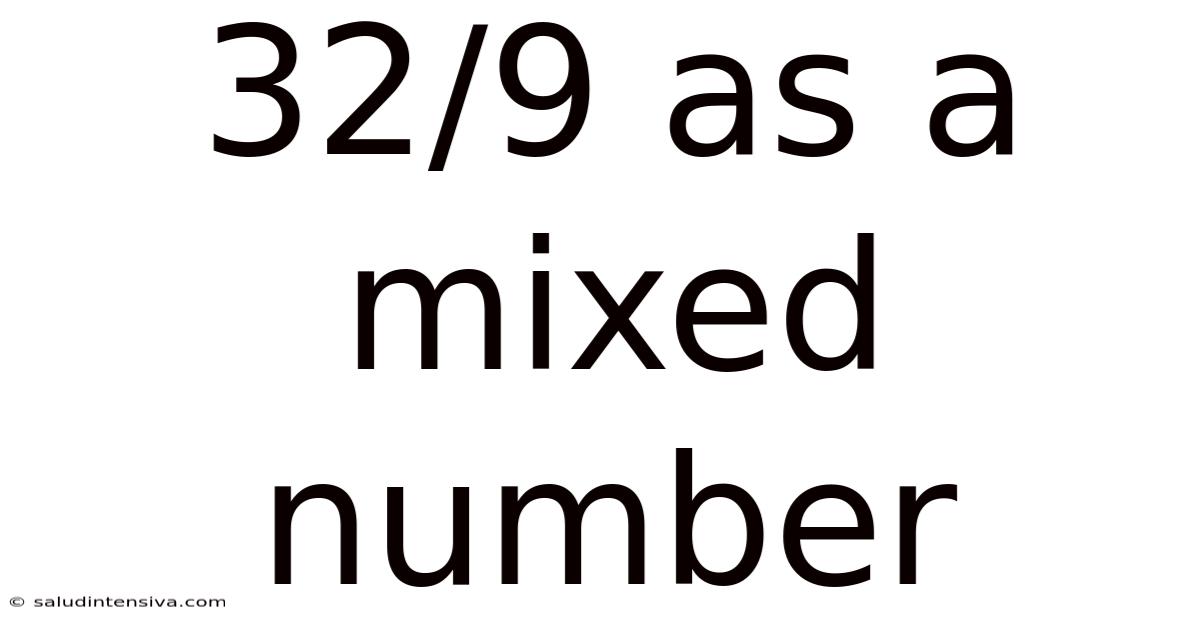32/9 As A Mixed Number
saludintensiva
Sep 19, 2025 · 5 min read

Table of Contents
Understanding 32/9 as a Mixed Number: A Comprehensive Guide
The seemingly simple fraction 32/9 might appear straightforward at first glance. However, understanding it as a mixed number unlocks a deeper understanding of fractional representation and lays the groundwork for more complex mathematical operations. This comprehensive guide will explore the conversion of 32/9 into a mixed number, delving into the underlying principles and providing practical examples. We’ll also address frequently asked questions and provide you with a solid foundation for working with mixed numbers.
What is a Mixed Number?
Before diving into the conversion, let's define what a mixed number is. A mixed number is a combination of a whole number and a proper fraction. A proper fraction is a fraction where the numerator (the top number) is smaller than the denominator (the bottom number). For example, 3 ½ is a mixed number, combining the whole number 3 and the proper fraction ½. Mixed numbers are a convenient way to represent quantities that are larger than one but not whole numbers.
Converting 32/9 to a Mixed Number: A Step-by-Step Approach
The process of converting an improper fraction (where the numerator is larger than or equal to the denominator) like 32/9 to a mixed number involves division. Here's a step-by-step guide:
-
Divide the Numerator by the Denominator: The first step is to perform the division 32 ÷ 9.
-
Determine the Whole Number: The result of this division will give you the whole number part of your mixed number. 32 divided by 9 is 3 with a remainder of 5. Therefore, the whole number part of our mixed number is 3.
-
Determine the Remainder: The remainder from the division becomes the numerator of the fractional part of the mixed number. In this case, the remainder is 5.
-
Keep the Original Denominator: The denominator of the fractional part remains the same as the original denominator. This means our denominator remains 9.
-
Combine the Whole Number and Fraction: Combine the whole number and the fraction to form the mixed number. Therefore, 32/9 as a mixed number is 3 5/9.
Visualizing the Conversion
Imagine you have 32 identical objects, and you want to group them into sets of 9. You can form three complete sets of 9, leaving you with 5 objects remaining. This visually represents the mixed number 3 5/9. Each complete set of 9 represents a whole number (1), and the remaining 5 objects represent the fraction 5/9.
Why Use Mixed Numbers?
Mixed numbers offer several advantages:
-
Intuitive Representation: They provide a more intuitive and easily understandable representation of quantities than improper fractions, especially in real-world contexts. Saying "I have 3 5/9 pizzas" is clearer than saying "I have 32/9 pizzas."
-
Simplified Calculations: In certain calculations, particularly addition and subtraction, using mixed numbers can simplify the process. Adding mixed numbers directly is often easier than converting them to improper fractions first.
-
Real-World Applications: Mixed numbers are frequently used in everyday life, from measuring ingredients in cooking to calculating distances and times.
Further Exploration: Working with Mixed Numbers
Once you understand how to convert improper fractions to mixed numbers, you can expand your skills to perform various operations with mixed numbers, including:
-
Addition and Subtraction: Add or subtract the whole number parts and then the fractional parts separately. If the fractional parts require it, you may need to find a common denominator.
-
Multiplication and Division: Converting mixed numbers to improper fractions before performing multiplication and division often simplifies the process.
Frequently Asked Questions (FAQ)
Q: Can all improper fractions be converted to mixed numbers?
A: Yes, every improper fraction can be converted into a mixed number. The only exception is when the numerator is an exact multiple of the denominator, resulting in a whole number.
Q: Is there more than one way to represent 32/9?
A: While 3 5/9 is the simplest representation, other equivalent forms exist. For instance, you could represent it as 6 14/18 or 9 23/27, but these are less efficient. The most useful and commonly used representation is the simplest form—3 5/9.
Q: What if the remainder is zero?
A: If the remainder after dividing the numerator by the denominator is zero, it means the original fraction was already a whole number. For example, 18/3 converts to 6.
Q: How can I check my work?
A: To verify your conversion, you can convert the mixed number back into an improper fraction. To do this, multiply the whole number by the denominator, add the numerator, and keep the same denominator. In our example, (3 x 9) + 5 = 32, so the improper fraction is 32/9 – confirming our conversion.
Conclusion
Converting an improper fraction like 32/9 to its mixed number equivalent, 3 5/9, is a fundamental skill in mathematics. Understanding this conversion not only enhances your comprehension of fractions but also prepares you for more advanced mathematical concepts and real-world applications. Remember the simple steps involved – divide, determine the whole number and remainder, and combine them to create your mixed number. Mastering this process empowers you with a more versatile and intuitive approach to working with fractions. Through practice and a grasp of the underlying principles, you’ll confidently navigate the world of fractions and mixed numbers.
Latest Posts
Latest Posts
-
Lcm Of 8 And 4
Sep 19, 2025
-
10 Out Of 15 Percent
Sep 19, 2025
-
How Long Is 340 Minutes
Sep 19, 2025
-
16 7 As A Mixed Number
Sep 19, 2025
-
Equivalent Fractions For 14 16
Sep 19, 2025
Related Post
Thank you for visiting our website which covers about 32/9 As A Mixed Number . We hope the information provided has been useful to you. Feel free to contact us if you have any questions or need further assistance. See you next time and don't miss to bookmark.